BY LETTER
Venus
Galactography > Regions of Space > Inner Sphere
Galactography > Other Major Polities, Empires, and Meta-Empires > Solsys Organization
Galactography > Other Major Polities, Empires, and Meta-Empires > Solsys Organization
The Early History and Terraformation of Venus | |
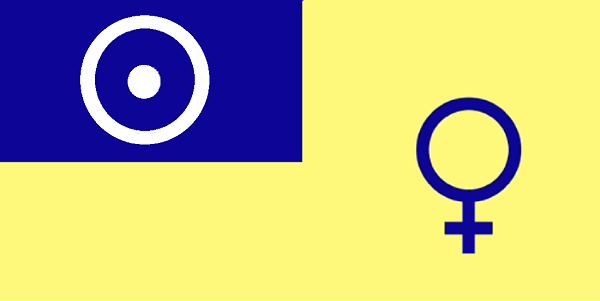 Image from MacGregor | |
| Flag of Venus Governing Authority. Includes the Solsys Organization flag (the Sun astronomical symbol on a dark blue background) in the canton, with yellow for pre-terraformed Venus, and the Venus astronomical symbol. | |
Venus - Data Panel | |
| World | Terrestrial Class Planet, Sol II |
|---|---|
| Diameter | 12104 km |
| Orbital radius | 0.723 AU |
| Planetology | Originally a hot dry greenhouse world, Cytherian type, with an atmosphere consisting mostly of carbon dioxide with a surface pressure 92 times greater than that of Earth. The planet was shrouded with clouds of sulphuric and hydrochloric acid and the mean surface temperature was 480C, making the world extremely hostile to terragen and carbon-based life. Because of this the planet was sparsely populated for many thousands of years; recently it has been successfully terraformed. |
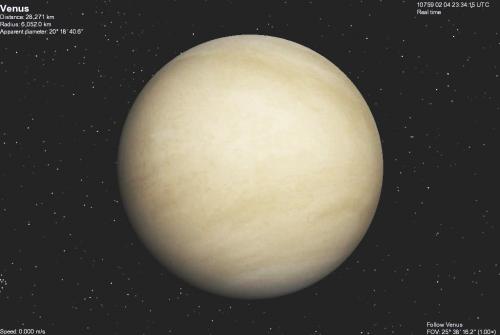 Image from Steve Bowers | |
| Venus before terraforming | |
| Venus in the Current Era | Population of Venus and the Diadem: 117 billion sophonts (65% sophtwares, 9% nearbaseline humans, 7% vecs, 6% superiors, 4% cyborg, 3% To'ul'hs, 5% other); most of these live in the Diadem Orbital Band Government: Venus Governing Authority (VGA), a protectorate of the Solsys Organization. Planetary Surface: With terraforming recently completed, the Venusian surface is covered in a beautiful saltwater ocean punctuated by a number of continents and islands with a wide variety of climates. The flora and fauna have been tailored to closely resemble that of Old Earth, with some neogen and adapted xenobiotic species included. While there are several important population centers such as Parmenides along the west coast of Aphrodite Terra, Horrocksville on the island of Eistla, and Lomonosovgrad in the Sedna Sea, most of the surface population live in small diffused settlements. Water craft are ubiquitous and range in size from a few meters to housing entire cities. Currently, only 2 billion physical inhabitants permanently live on the surface and the Solsys Organization is taking steps to prevent overcrowding. Orbital Space: The large dynamically-stabilized sunshade known as the Parasol in L1 orbit protects Venus from the Sun's more harmful effects. An impressive orbital band called the Diadem encircles Venus where the vast majority of the population lives; the ancestors of many of these residents had long lived in Venusian orbit in earlier habitats. Diadem is also the main computronium node for the planet's S2 AI overseer Anchises, who manages most day to day operations on behalf of the Solsys Organization. Separate from the band, other stations abound. New J'ufar, a large Bernal sphere designed to support a sizable population of To'ul'hs, is in distant orbit around the planet and serves as a reminder of To'ul'h colonization in the pre-terraformed era. Industries: simaesthetics, totalrecalls, biotics, To'ul'h tourism |
|---|
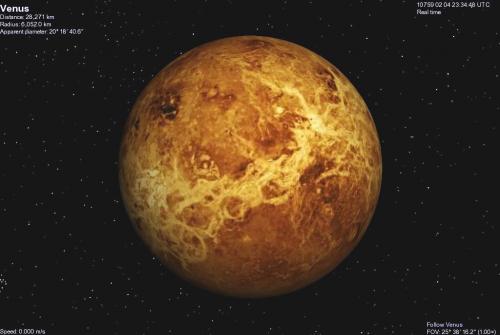 Image from Steve Bowers | |
| Venus before terraforming, without clouds | |
Venus in the Interplanetary Age
This inhospitable planet was the target of several commercial efforts during the Interplanetary age of the Solar System. A small, permanent habitat of the Stanford Torus type was placed in orbit in 150 AT; this was a climatological research centre jointly run by Mitsubishi and the European Science Foundation. Later a number of similar habitats and installations were constructed by carbon miners, who were engaged in skimming material from the top of the hot planet's atmosphere. Important mining consortia from this period include IshtarCorp and SkyScoop.Meanwhile a small swarm of solar power collectors was being built at the planet's L1 point, just over a million kilometres from Venus in the direction of the Sun. Independent power swarms and habitats were established in the Venus/Sun L4 and L5 points; these habitats are always distant from Venus, and have always considered themselves to be independent from that planet. For a while the Evening Star was the focus of intensive activity; carbon was exported to the Moon, the Cislunar orbitals, and other carbon poor locations. High-tech finished goods, carbon buckyfibre and diamondoid products were being manufactured in orbit and in the L1 swarm.
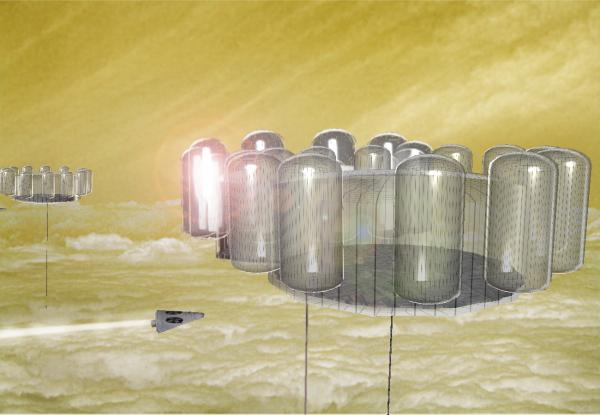 Image from Steve Bowers | |
| Landis bubblehabs at Venus' 50km level (before this world was terraformed) | |
A number of small bubblehabs were built at this time suspended at the 50 kilometer level, some large enough to support agriculture for food production. The ample sunlight available above the clouds and the energy available from the planet's superrotating atmosphere allowed the Venusian habitats to become self sufficient by 300 AT (2269 CE). During the fifth century AT the Venus Terraformation Project established a large habitat in LVO; this organisation also set up an extensive automated outpost near Cleopatra Patera in the northern highlands of Ishtar Terra.
Venus Deserted and Reclaimed
As a result of the combined effects of the swarms, malware, and protowars during and after the Technocalypse starting in 565, by 700 AT all permanent occupation of the space around Venus had been abandoned. By the establishment of the First Federation several new sets of colonists were reclaiming the abandoned orbitals, the atmosphere, and perhaps more importantly the L1 power swarm. A new effort to terraform the planet was commenced with the diversion of a number of small Aten-type asteroids into Venus orbit, but the Second Venus Terraforming Project went bankrupt shortly afterwards. Eventually this material was used in the construction of a dynamic orbital ring, completed in 3221.The Venus Tweaks and the Skydweller War
During the Second Federation, the TwinStream cybertweaks (an ex-Genetekker group) began to develop an extremophile tweak human clade that could survive higher temperatures and pressures so as to colonise deeper cloud layers. This effort was only partially successful after more than a thousand years of experiment, eventually giving rise to a clade template suited to 10 atm, 120°C ambient conditions (though iteratively better clade templates allowed for deeper colonies throughout this period). The lower wind speeds of the 25-35km cloud layers allowed for easier construction of tethered floating settlements, known as Landis Balloons, that used aerostatic radiators to cool themselves a hundred degrees less than the outside layer (short term exposure to the outside clouds became a popular recreational activity; more widely known as the Venusian Sauna). In a few short centuries significant hab space was constructed in this format at multiple levels. At the same time the upper atmosphere of Venus was recolonised using bubblehab flotillas better suited to the high wind speeds; with carbon-polymer skins and supported by oxygen, these habitats could be constructed from local materials and soon thousands of square kilometres of floating balloon landscape was suspended above the hot surface.In conjunction with the growing tweak population in the tethered cities new vec clades were designed to inhabit the surface. The idea of a thriving mechanosystem never fully reached fruition, the hostile conditions thwarting any attempts at suitably complex mechanosystems. However some designs were rugged enough that vec communities populated sealed habitats at the base of the Landis tethers. Using them as cooling elements to colder, higher altitudes they cooled their habs to a mere 200°C, maintaining the same pressure as the surface for simpler construction.
In 4331 war broke out between the Venusian tweak extremophiles and the skydwellers; the difference in philosophy between those who wished to create habitats suitable for nearbaseline humanity and those who were prepared to modify themselves to adapt to the environment was wide and eventually became violent. This war ended in disaster for the skydwellers, as their flimsy habitats could not stand much damage before failing catastrophically. Despite winning the conflict many deeper layer societies were so ostracised by the wider Solsys culture (and perhaps more importantly the surface vec dwellers at the tether bases) that they were effectively driven from the Solar System, bearing the collective guilt of economic inconvenience of the conflict which resulted in millions of temporary deaths and the loss of many priceless cultural artefacts. These Venus adapted tweaks emigrated to planets with Venus-like environments all over the Orion Arm.
The Venus-Adapted To'ul'hs
After the Version War (which barely touched the Solar System) Venus became a destination for the alien species known as the To'ul'hs; discovered in Ophiuchus in 3831 AT, these intelligent aliens were studied for hundreds of years before they joined the mainstream Orion's Arm civilisation. Many To'ul'h philosopher/scientists were intrigued by the Human home system, and they expressed a wish to visit the old worlds; eventually a Venus-adapted to'ulmorph was developed, allowing the xenosophonts to live freely on the hot, dry surface of Venus. There was a small Venus-adapted To'ul'h habitat near Maxwell Montes, and another along the canyons of Aphrodite Terra.At this time new Landis balloon habitats were built, eventually encircling the globe; turbine wind generators were suspended at various heights to extract power, and above all the skyminers were lifting carbon and oxygen using scoops suspended from the orbital ring. It is notable that the cult of GAIA was very strong on this world; the skydwellers called Venus the 'daughter of Gaia', and it is known that She had introduced an extensive and advanced monitoring system to watch over the Earth's sister planet.
Venus Finally Terraformed
Over thousands of years the atmosphere was slowly depleted, until the planet was so different from its original condition that the idea of terraforming was once again suggested. By 8977 a viable scheme for terraformation was agreed upon, and over the next thousand years it was finally achieved.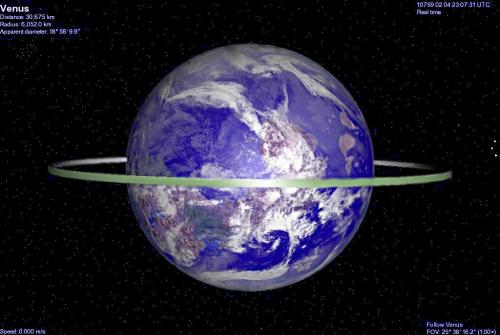 Image from Steve Bowers | |
| Venus in the last stages of terraforming; the orbital ring, built using excess atmospheric carbon, can be seen. This ring has now been converted into an Orbital Band known as the Diadem, consisting of thousands of smaller habitats and computronum nodes | |
1) A gigantic, dynamically-stabilized sunshade (also known as a 'parasol') (thousands of km across, but no thicker than necessary for stability and to blot out the sun) with an integral magshield was placed at the L1 position of Sol-Venus to start cooling the planet, also blocking the nastiest components of Sol's output. The magnetosphere and ozone layer eventually produced for the terraformed planet were not sufficient to protect the surface from solar flux, and the shade blocks direct illumination allowing artificial diurnal illumination.
2) Huge "radiator fins" hundreds of kilometres tall and tens of kilometres broad, but also very thin, were lowered into Venus' atmosphere from the dynamically-supported mass ring around the equator, to conduct the excess heat out of Venus' atmosphere and radiate it away into space to help speed the cooling-off.
3) A large number of comets were directed from the outer system, using momentum exchange with Uranus and Saturn, onto the planet to bring H2O once the temperature dropped below the boiling point. By this time the population of To'ul'hs and balloonriders had been evacuated, a process which in itself was not without difficulties. During this period the famous but short-lived Cytherea's Diadem was formed, a temporary debris ring around Venus.
The process of bringing water/ice from the outer system was augmented with imports of hydrogen from the Sun; a corporation of Sunminers arrived via the Nexus from Aldebaran in 9230 and were responsible for much of the water of the Venusian oceans.
4) Masses of microbial plant, algae, and other photosynthetic microbes were dropped on the planet, to deal with excess CO2 by locking it up in a biosphere. The CO2 content of Venus's atmosphere was too large to be simply incorporated into a biosphere, however massive, so a proportion was incorporated into synthetic limestone rocks while much of the rest was removed for export.
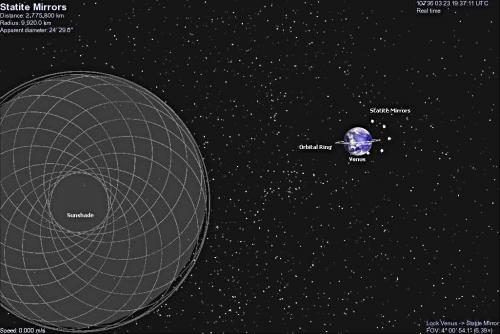 Image from Steve Bowers | |
| Venus as seen from the Sunshade; the orbital ring can be seen, and behind Venus the ring of statite mirrors (note: this image is extremely foreshortened; the shade is 1 million kilometers closer to the viewpoint than Venus, and the statite mirrors are fifty thousand kilometers further away) | |
5) A ring of statite reflectors were placed behind Venus suspended on the sunlight against Venus' gravitational pull. These mirrors have smart surfaces, which direct a variable eight- to sixteen-hour period of sunlight (minus certain wavelengths and other solar emissions which are not needed) onto Venus to simulate an Earth-like 24-hour day-night cycle without actually altering the planet's rotation. The sunward side of Venus is illuminated during the artificial daylight period by light retransmitted by the sunshade, and the other side is illuminated by the ring of mirrors. The whole planet shares the same day-night cycle, with the whole world illuminated at the same time (there is only one time zone, in other words).
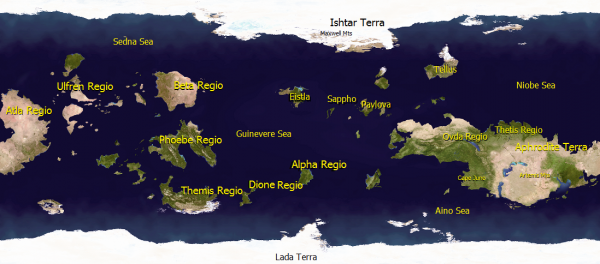 Image from Steve Bowers | |
| Terraformed Venus - surface features (terraformed Venus texture by Runar Thorvaldsen - used with permission) | |
By the year 10000 AT Venus was ready for habitation by nearbaseline humans and other Earth-derived species. The population of the planet in 10400 already reached two billion and population controls were soon necessary. All trace of nanotech monitoring equipment controlled by GAIA has disappeared, replaced by systems controlled by the local S:2, known as Anchises.
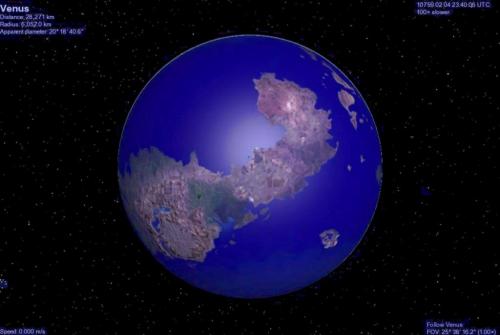 Image from Steve Bowers | |
| Terraformed Venus as seen from space (without clouds) | |
The Day-Night Cycle on Venus
From the sunward surface the sunshade looks like a larger version of the Sun. Because it shades the whole planet the sunshade (which is 38,000 km in diameter) looks 3 times as wide in the sky than the Sun would if it were visible. The sunshade transmits light towards Venus actively, instead of simply allowing light to come through, so it appears to be a very large, bright circle in the sky, more than two degrees in diameter - but no brighter overall than the Sun seen from Earth. As Venus slowly rotates underneath the sunshade, this large disk appears to move across the sky over a period of 116 Earth days, rising in the West and setting in the East.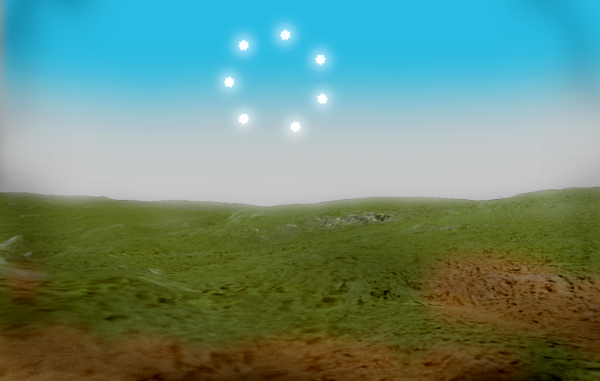 Image from Steve Bowers | |
| The terraformed surface of Venus, showing the ring of mirrors which illuminates the planet. Since this image was taken, the ring has become a continuous circle. | |
As the big luminous sunshade slowly sets, a ring of lights rises in the opposite direction - these are the statite mirrors. In the Current Era these mirrors form a continuous circle. The hole in the centre is where the shadow of the sunshade falls - this shadow is about 40,000km across at that distance, so the mirror ring has a hole in it slightly larger than the sunshade. It is, however, quite a thin ring- the whole ring only needs to reflect the light to mimic the brightness of Earth daylight, so the thickness of the ring is less than 5 arc minutes wide and still appears as bright in the sky as the Sun as seen from Earth.
In one direction the inhabitants see a big, bloated sun-like disk 2 degrees across, and in the other direction a thin ring which is even wider, but both give the same amount of light. During terraformed Venus' 'night-time', both these objects appear dark. The sunshade simply stops transmitting light, but the statite mirrors tilt slightly so that their reflected sunlight misses Venus. Both structures are quite complex, sophisticated objects, under active control - but both are very lightweight.
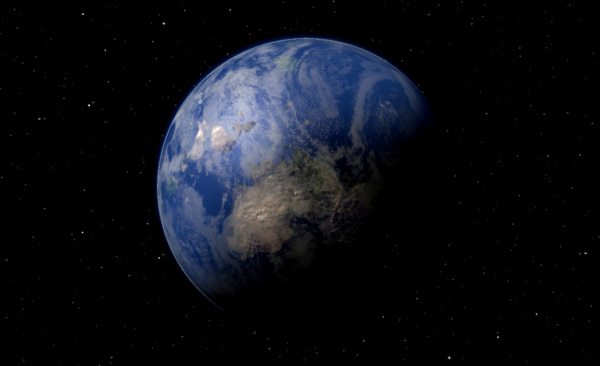 Image from Steve Bowers, using Runar Thorvaldsen's textures | |
| Terraformed Venus, after the Orbital Ring was finally removed in 10460 | |
Related Articles
Appears in Topics
Development Notes
Text by M. Alan Kazlev and Anders Sandberg 2002, Steve Bowers and Mike Parisi 2006.
Additional material by MacGregor, Steve Bowers, AI Vin and Ad Astra in July 2017.
Initially published on 02 August 2002.
Additional material by MacGregor, Steve Bowers, AI Vin and Ad Astra in July 2017.
Initially published on 02 August 2002.
Additional Information
Runar Thorvaldsen's Celestia addon for a Terraformed Venus available here






